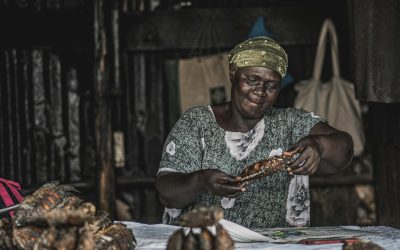On January 28, 1956, a lioness gave birth to three cubs in Meru National Park, Kenya. Just four days later, game warden George Adamson was forced to shoot the lioness in self-defense when she tried to protect her young. This tragic incident left the three cubs orphaned. George and his wife, Joy Adamson, made the life-changing decision to adopt and care for them, including the remarkable Elsa the Lioness.
The cubs were named Big One, Lustica, and Elsa the Lioness. While Big One and Lustica were eventually transferred to Rotterdam Zoo in the Netherlands, the Adamsons chose to raise Elsa themselves. Thus began the incredible journey of Elsa the Lioness.
The Journey of Elsa the Lioness
Elsa grew up in the Adamsons’ care and lived more like a domestic pet than a wild animal. She developed a close and loving bond with Joy Adamson, who dedicated herself to teaching Elsa the necessary skills to survive in the wild. Joy was determined to see Elsa live freely and worked tirelessly to train her to hunt and fend for herself.

By 1958, when Elsa was two years old, Joy’s efforts bore fruit. Elsa was successfully released back into the wild—a monumental achievement that was later chronicled in Joy Adamson’s bestselling book, Born Free. The book brought worldwide fame to Elsa and earned the Adamsons immense recognition for their conservation work.
Challenges in the Wild
Life in the wild came with its own set of challenges. Elsa was once attacked by a pack of wild female lions and was gravely injured. She managed to return to the Adamsons’ camp, where George and Joy nursed her back to health. After recovering, Elsa ventured back into the wild, but she would frequently return to visit the camp. Her longest stretch away from the Adamsons was six weeks.
Elsa’s Cubs
Elsa eventually had three cubs of her own: a male named Joseph and two females, Gopa and Little Elsa. She brought her cubs back to the Adamsons’ camp, where George named them. As they grew older, the cubs learned to live independently and ventured out into the wild.
Elsa’s Untimely Death
Tragically, Elsa’s life was cut short. On January 24, 1961, just four days shy of her fifth birthday, Elsa succumbed to babesiosis, a tick-borne disease that affects members of the cat family. With a high fever from the infection, Elsa made her way back to the Adamsons’ camp, where George found her. Joy was away in England at the time. Elsa passed away in George’s arms in the doorway of his tent, leaving behind a legacy of love and resilience.
Elsa’s Resting Place
Elsa the Lioness, often referred to as “the blessed lioness of Africa” and “the Adamson lioness,” is buried at the Joy Adamson gravesite in Meru National Park, Kenya. Her story continues to inspire wildlife conservation efforts and stands as a testament to the powerful bond between humans and animals.
Visit the born free legacy

The former home of George and Joy Adamson, renowned conservationists and authors of Born Free, has been transformed into a charming hotel in Kenya. Located in the heart of Kora National Park, this historic site offers guests a unique opportunity to connect with the legacy of the Adamsons, who dedicated their lives to wildlife conservation, particularly the rehabilitation and release of lions into the wild. The property retains its rustic charm, featuring simple yet elegant accommodations that harmonize with the surrounding wilderness. Visitors can enjoy guided safaris, explore the breathtaking landscapes, and immerse themselves in the rich history of the Adamsons’ pioneering conservation work. The hotel stands as a tribute to their enduring legacy, inviting travelers to experience the beauty of the wild they fought so hard to protect.
🦁 Elsa the Lioness Sculpture – London
Location: Regent’s Park, London, UK
Unveiled: 2012
Artist: Gillie and Marc Schattner
This bronze sculpture depicts Elsa the lioness in a gentle, noble pose. It was installed by the Born Free Foundation to celebrate the life of Elsa and the Adamsons’ work. The statue captures Elsa’s wild beauty and calm nature, making it a favorite photo spot for visitors. The plaque at the base highlights Elsa’s story and the ongoing mission of wildlife conservation.
The London sculpture was also meant to raise awareness about captive wild animals in circuses and zoos, connecting to the Born Free Foundation’s campaigns for animal rights and ethical treatment.

🌍 Other Notable Elsa-Related Sculptures and Tributes
Meru National Park, Kenya
This is the park where Elsa was released into the wild. While not always a formal sculpture, memorial markers and plaques at Elsa’s grave (a short hike from Elsa’s Kopje Lodge) serve as sacred tributes to her life. Visitors often hike to this peaceful spot to pay their respects and reflect on Elsa’s unique journey.
Elsa Murals and Artistic Tributes
In some cities (e.g., Nairobi, Vienna, Cape Town), wildlife artists and conservation groups have created murals or temporary installations to honor Elsa. These often coincide with anniversaries of Born Free or World Wildlife Day events.
🎗️ Legacy of the Elsa Sculptures
These sculptures are more than art—they’re symbols of hope, education, and a call to action. They honor the extraordinary story of a lioness who lived between two worlds—human care and the African wild—and remind us of the fragile balance between freedom and captivity in the animal kingdom.





0 Comments